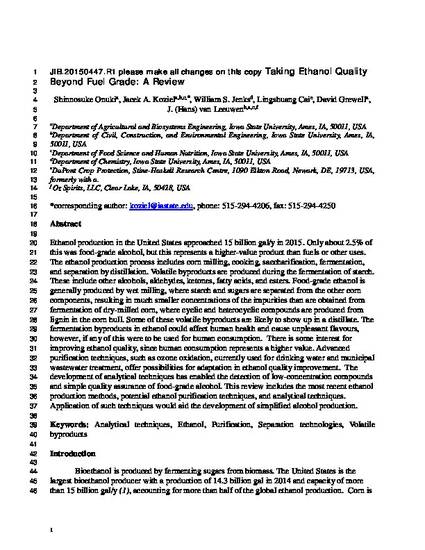
Ethanol production in the United States approached 15 billion gal/year in 2015. Only about 2.5% of this was food‐grade alcohol, but this represents a higher‐value product than fuels or other uses. The ethanol production process includes corn milling, cooking, saccharification, fermentation, and separation by distillation. Volatile byproducts are produced during the fermentation of starch. These include other alcohols, aldehydes, ketones, fatty acids and esters. Food‐grade ethanol is generally produced by wet milling, where starch and sugars are separated from the other corn components, resulting in much smaller concentrations of the impurities than are obtained from fermentation of dry‐milled corn, where cyclic and heterocyclic compounds are produced from lignin in the corn hull. Some of these volatile byproducts are likely to show up in the distillate and these fermentation byproducts in ethanol could cause unpleasant flavours and affect human health if used for human consumption. There is some interest in improving ethanol quality, since human consumption represents a higher value. Advanced purification techniques, such as ozone oxidation, currently used for drinking water and municipal wastewater treatment, offer possibilities for adaptation in ethanol quality improvement. The development of analytical techniques has enabled the detection of low‐concentration compounds and simple quality assurance of food‐grade alcohol. This review includes the most recent ethanol production methods, potential ethanol purification techniques and analytical techniques. Application of such techniques would aid in the development of simplified alcohol production.
Available at: http://works.bepress.com/jacek_koziel/166/

This is an Accepted Manuscript of an article published by Taylor & Francis as Onuki, Shinnosuke, Jacek A. Koziel, William S. Jenks, Lingshuang Cai, David Grewell, and J. H. Leeuwen. "Taking ethanol quality beyond fuel grade: A review." Journal of the Institute of Brewing 122, no. 4 (2016): 588-598. DOI: 10.1002/jib.364. Posted with permission.